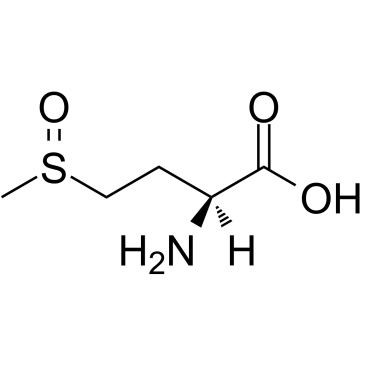H-Met(O)-OH

H-Met(O)-OH structure
|
Common Name | H-Met(O)-OH | ||
|---|---|---|---|---|
| CAS Number | 3226-65-1 | Molecular Weight | 165.211 | |
| Density | 1.4±0.1 g/cm3 | Boiling Point | 434.3±40.0 °C at 760 mmHg | |
| Molecular Formula | C5H11NO3S | Melting Point | 234-235ºC | |
| MSDS | Chinese USA | Flash Point | 216.4±27.3 °C | |
| Symbol |

GHS07 |
Signal Word | Warning | |
|
Copper(II) complexes of neurokinin A with point mutation (S5A) and products of copper-catalyzed oxidation; role of serine residue in peptides containing neurokinin A sequence.
J. Inorg. Biochem. 121 , 1-9, (2013) A potentiometric, spectroscopic (UV-visible, CD and EPR) and electrospray ionization mass spectrometric (ESI-MS) study of Cu(II) binding to the neurokinin A with point mutation (S5A) (ANKA), His-Lys-Thr-Asp-Ala(5)-Phe-Val-Gly-Leu-Met-NH2 and its N-acethyl der... |
|
|
Changes of metabolic profiles in an oral squamous cell carcinoma cell line induced by eugenol.
In Vivo 27(2) , 233-43, (2013) We have recently reported that eugenol exerted indiscriminate cytotoxicity towards normal oral cells and oral squamous cell carcinoma (OSCC) cell lines without induction of apoptosis markers. In order to investigate the underlying mechanisms of cytotoxicity i... |
|
|
Arrest defective 1 regulates the oxidative stress response in human cells and mice by acetylating methionine sulfoxide reductase A.
Cell Death Dis. 5 , e1490, (2014) Methionine sulfoxide reductase A (MSRA) protects proteins from oxidation, and also helps remove reactive oxygen species (ROS) by recovering antioxidant enzymes inactivated by oxidation. Although its functions have been investigated extensively, little is know... |
|
|
Redox-sensitive residue in the actin-binding interface of myosin.
Biochem. Biophys. Res. Commun. 453(3) , 345-9, (2014) We have examined the chemical and functional reversibility of oxidative modification in myosin. Redox regulation has emerged as a crucial modulator of protein function, with particular relevance to aging. We previously identified a single methionine residue i... |
|
|
A sulfonium cation intermediate in the mechanism of methionine sulfoxide reductase B: a DFT study.
J. Phys. Chem. B 115(29) , 9202-12, (2011) The hybrid density functional theory method B3LYP in combination with three systematically larger active site models has been used to investigate the substrate binding and catalytic mechanism by which Neisseria gonorrhoeae methionine sulfoxide reductase B (Ms... |
|
|
An electrophoretic mobility shift assay for methionine sulfoxide in proteins.
Anal. Biochem. 421(2) , 767-9, (2012) Study of the posttranslational modification of methionine to its sulfoxide has been receiving increasing attention because of its implication in regulation of protein activity, but techniques for the detection of this modification remain limited. In particula... |
|
|
Methionine sulfoxide reduction in ciliates: characterization of the ready-to-use methionine sulfoxide-R-reductase genes in Euplotes.
Gene 515(1) , 110-6, (2013) Genes encoding the enzyme methionine sulfoxide reductase type B, specific to the reduction of the oxidized methionine-R form, were characterized from the expressed (macronuclear) genome of two ecologically separate marine species of Euplotes, i.e. temperate w... |
|
|
Two fluorescent wavelengths, 440(ex)/520(em) nm and 370(ex)/440(em) nm, reflect advanced glycation and oxidation end products in human skin without diabetes.
Diabetes Technol. Ther. 14(3) , 285-92, (2012) Advanced glycation end products (AGEs) and oxidation products (OPs) play an important role in diabetes complications, aging, and damage from sun exposure. Measurement of skin autofluorescence (SAF) has been promoted as a noninvasive technique to measure skin ... |
|
|
Operational dissection of β-amyloid cytopathic effects on cultured neurons.
J. Neurosci. Res. 91(5) , 706-16, (2013) Alzheimer disease (AD) affects mainly people over the age of 65 years, suffering from different clinical symptoms such as progressive decline in memory, thinking, language, and learning capacity. The toxic role of β-amyloid peptide (Aβ) has now shifted from i... |
|
|
Characterization of methionine oxidation and methionine sulfoxide reduction using methionine-rich cysteine-free proteins.
BMC Biochem. 13 , 21, (2012) Methionine (Met) residues in proteins can be readily oxidized by reactive oxygen species to Met sulfoxide (MetO). MetO is a promising physiological marker of oxidative stress and its inefficient repair by MetO reductases (Msrs) has been linked to neurodegener... |